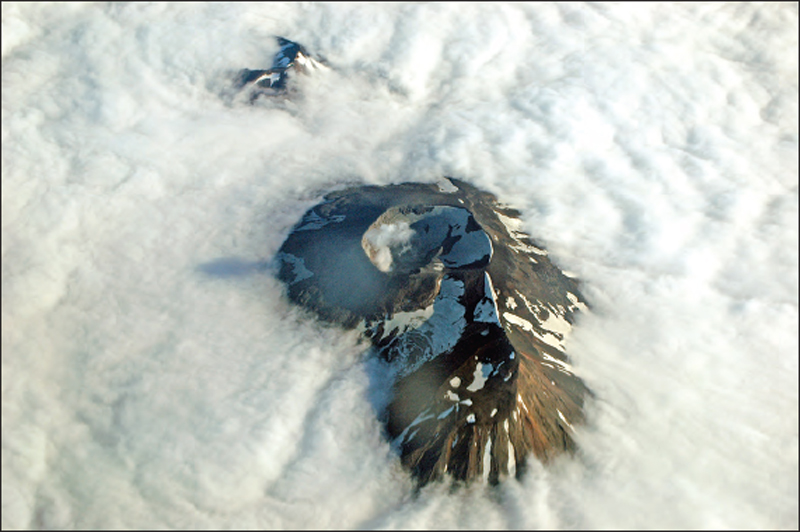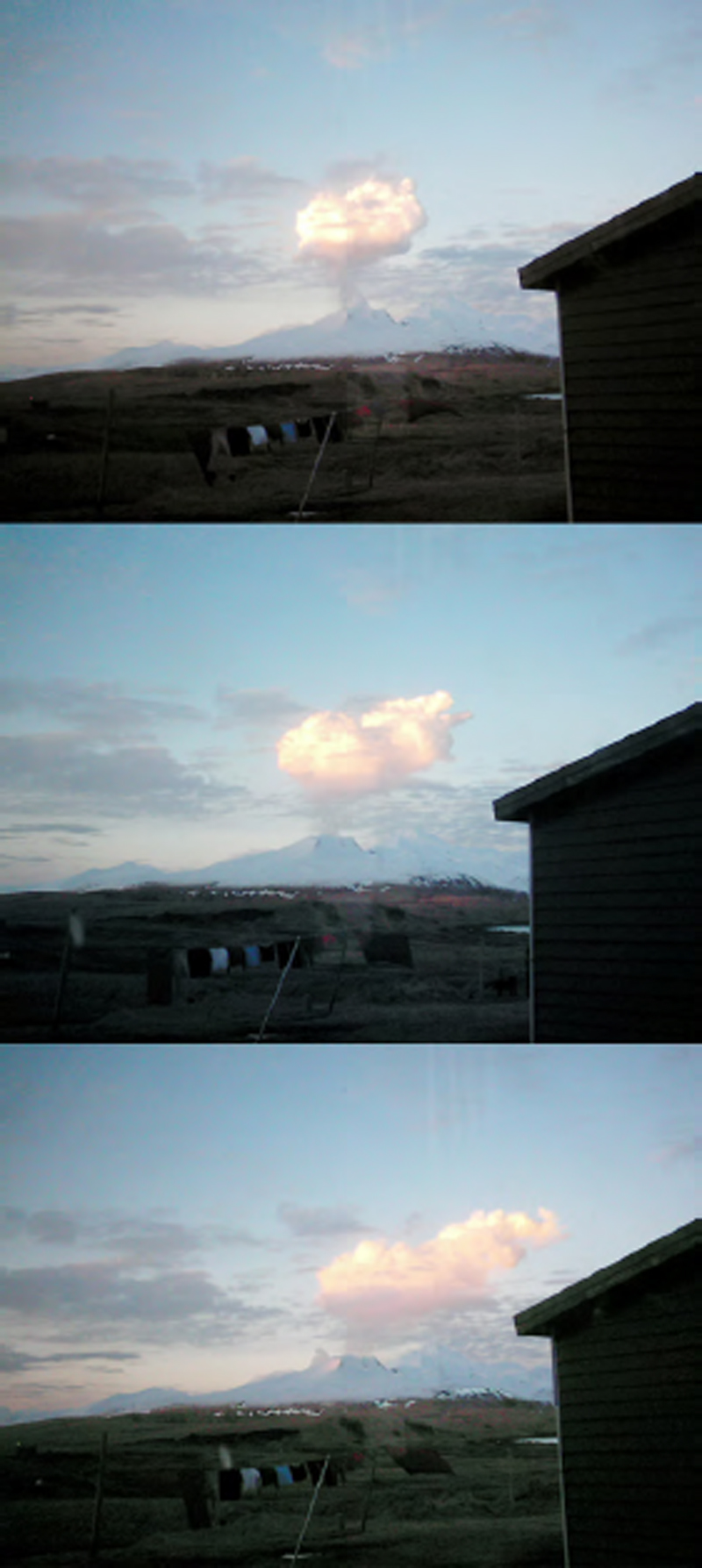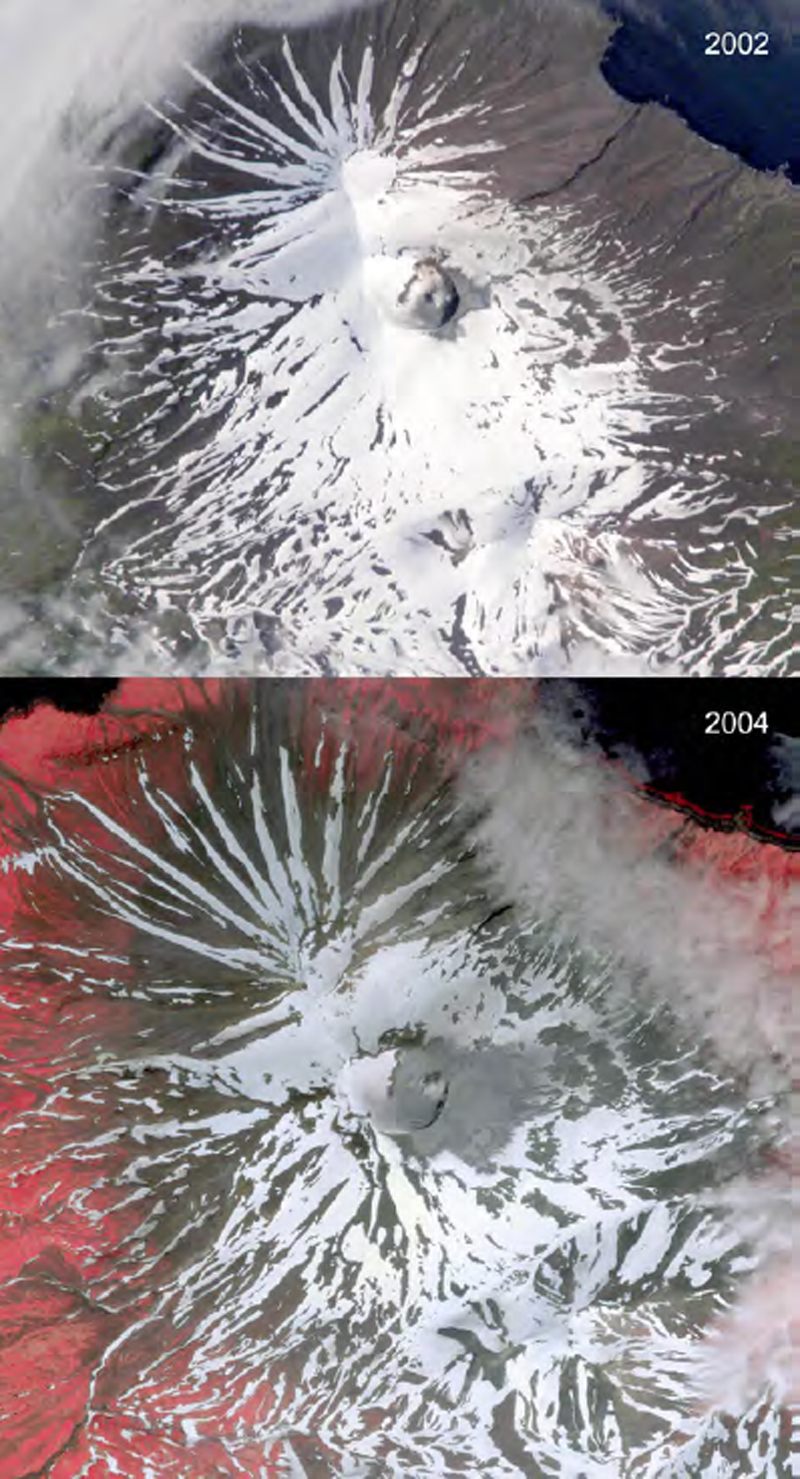Report on Atka Volcanic Complex (United States) — November 2014
Bulletin of the Global Volcanism Network, vol. 39, no. 11 (November 2014)
Managing Editor: Richard Wunderman.
Atka Volcanic Complex (United States) Summary of activity during 1998-2007
Please cite this report as:
Global Volcanism Program, 2014. Report on Atka Volcanic Complex (United States) (Wunderman, R., ed.). Bulletin of the Global Volcanism Network, 39:11. Smithsonian Institution. https://doi.org/10.5479/si.GVP.BGVN201411-311160
Atka Volcanic Complex
United States
52.331°N, 174.139°W; summit elev. 1518 m
All times are local (unless otherwise noted)
Korovin is a stratovolcano located on Atka Island in the central Aleutian Islands; its most recent reported activity ended in 2007. This report summarizes and contains new information on activity from 1998 to 2007 by drawing on information primarily from the Alaska Volcano Observatory (AVO) and their cited publications. Much of the summary takes the form of a table at the end of the report.
Atka volcanic complex. According to Myers and others (2002) Korovin is a part of the 360 km2 Atka volcanic complex, found on the northern part of Atka Island. It is the largest modern complex within the central Aleutians (Myers and others, 2002). The ancestral Atka volcano, in the complex, was described as a large shield volcano consisting of basaltic and basaltic andesite flows, which was subsequently surrounded by a series of satellite vents (Myers and others, 2002).
A caldera forming eruption at the Atka shield volcano occurred ~300,000-500,000 years ago, creating a 5-km-diameter caldera. Associated with that event was the eruption of a large dacitic flow, called Big Pink. Regarding the composition of Big Pink, Myers and others (2002) said, "It consists of pumiceous and glassy units but is not associated with any ash flows." After the caldera formation, the volcanic centers of Korovin, Kliuchef, Konia and Sarichef formed. Figure 4 is a topographic map showing the location of these four volcanic centers and the location of the Atka caldera. These structures all comprise the Atka volcanic complex.
Korovin volcano. Korovin is located 21 km NE from the town of Atka (figure 4). It is the largest and tallest volcano of the post-caldera volcanic centers within the Atka volcanic complex. According to Myers and others (2002), Korovin shows little evidence of glaciation, unlike Kliuchef, located ~5 km S of Korovin. Regarding Korovin' edifice and age, Myers and others (2002) say "Its uneroded form suggests the volcano is mostly Holocene in age."
Korovin has a basal diameter of ~7 km and two summit vents located 0.6 km apart (Myers and others, 2002). The NW summit vent has a small crater and is the lower of the two vents. The SE summit has a 1 km wide crater, with steep walls and a depth of several hundred meters (Myers and others, 2002). The SE summit crater sometimes contains a crater lake and is considered Korovin's active crater. Figure 5 is an aerial photo of Korovin, highlighting its two summit vents.
During the summer of 2004, AVO installed a network of seismic stations throughout the northern part of Atka Island. Data from the network was accessible in March 2005; however, it wasn't until December 2005 that Korovin was considered seismically monitored. On 2 December 2005, Korovin was also officially assigned the Level of Concern Color Code Green after "a sufficient period of background seismicity had been recorded" (McGimsey and others, 2007). Before, AVO had listed Korovin as UA (unassigned) during periods when no significant activity was noted. AVO assigns volcanoes UA when there is no real-time seismic network in the area that can be used to define background levels of seismicity.
In addition to being seismically monitored, Korovin is also monitored through ground-based, aerial, and satellite imagery and photographs. Korovin and its plumes are often photographed by residents of Atka village (figures 6 and 7), which are then sent to the AVO. Figure 8 provides examples of photos of Korovin taken from satellites. Images from figures 6-8 furnish various kinds of evidence, from steaming (i.e. non-eruptive cases, figure 7), ash-bearing plumes (figure 6), and the result of ash-bearing eruptions (ash on the snow surface seen in satellite views, figure 8). Evidence of these kinds is summarized in next section.
Activity during 1998-2007. During this interval (table 1), activity ranged from eruptive cases to those that were considered non eruptive.
Activity was often reported to AVO by Atka village residents and pilots in the area. Korovin was also monitored through satellite imagery, when weather conditions were favorable. During this interval, the highest plumes were observed on 30 June 1998 and reached an altitude of ~9.1 km. As activity varied, the Aviation Color Code (ACC), the Volcanic Activity Alert Level (VAAL), and the Level of Concern Color Code (LCCC) were changed to reflect Korovin's activity status.
AVO presented general information on reported activity from 1998-2007 on their website. For each of the events within this interval, AVO cited information from several sources, some of which included the following: McGimsey and others (2003), which discussed activity in 1998; McGimsey and others (2008), which discussed 2005 activity; Neal and others (2009) that looked at 2006 activity; and McGimsey and others (2011) that detailed 2007 activity. AVO also referenced several past Bulletin reports, which highlighted Korovin activity (BGVN 23:06, and 31:02).
Our summary in table 1 summarizes the following: (1) the basic information on Korovin's activity from the AVO website and (2) additional information from some of AVO's cited references. Greater detail can be found on AVO's website and in their cited references.
Table 1. Condensed descriptions of key events during both eruptive and non-eruptive periods during 1987-2007. The data sources are stated in the table. The Remarks column generally contains the following: (1) "AVO:" This presents a very brief synopsis of the summary that AVO provides on each of their Korovin reported activity web pages (as accessed in May 2015). (2) Below that, we present a succinct timeline of Korovin activity created using on information found in some of AVO's cited references. The 2005 activity is in two sections to highlight different periods of activity during that year; 2006-2007 is considered one period of activity. Where AVO cited references are augmented by past Bulletin reports, the information has been [bracketed]. Times are all local, unless otherwise stated. The term 'resident(s)' refers to resident(s) of Atka village. Abbreviations used are as follows: Village Public Safety Officer, VPSO; above sea level, a.s.l., and Interferometric synthetic aperture radar, InSAR; Aviation Color Code, ACC; Volcanic Activity Alert Level, VAAL; Level of Concern Color Code, LCCC; unassigned activity (UA); and satellite-based Ozone Monitoring Instrument, OMI.
| Date | Remarks |
| 1998 |
AVO: Eruption started, 30 June 1998 ±1 month. Eruption end, 30 June 1998 ± 7 days McGimsey and others (2003): Eruption start / stop dates: 30 June / 8 July "…, the timing of this activity remains poorly constrained; intermittent ash may, in fact, have occurred weeks or prior to June 30." 10 May- Pilot observed ash on SE slope. Pilot had seen no ash the previous week and speculated the ash was deposited a few days prior to May 10 28 June-Individual reported a dark ash plume over Korovin 30 June-VPSO in Atka village reported two separate clouds, first at ~0730 and second at ~0830. Second cloud rose ~9.1 km and was tinted orange. VPSO said events "produced dustings of ash in Atka". AVO received 2 pilot reports: (1) at 1115, noted volcanic cloud reached ~4.9 km a.s.l., (2) at 1720, cloud to 9.1 km near Korovin 2 July- Resident reported a 'rusty' cloud, ~4.9 km a.s.l. moving SE 3 July- Pilot reported profuse steam from summit crater and ash on S, SE and E flanks. Thin trail of ash extended SW towards Atka village 8 July- AVO noted minor, weakly ash-bearing clouds over Korovin with satellite images |
| 2002 |
AVO: Eruption started, July 2002 ±1 month. Considered a questionable eruption McGimsey and others (2008): 5 July- Satellite photo of ash deposits on upper E flank of Korovin (figure 8, top). "Intermittent, minor phreatic eruptions through a hot, roiling lake in the south summit crater of Korovin [is] the probable source." |
| 2004 |
AVO: Eruption started, June 2004 ±1 month. Considered a questionable eruption McGimsey and others (2008): 4 July- Satellite photograph shows ash deposits on upper E flank of Korovin (figure 8, bottom). Same explanation as 5 July 2002 Neal and others (2009): 7 July- Korovin photographed with ash covering the snow on its E flank. According to the caption of the photograph, "The deposit may be the result of phreatic explosions or vigorous wind remobilization of ash from within the summit crater." 19 July- Aerial photograph of Korovin showing ash deposited around the crater vent. The caption for the photograph states, "At times, a shallow body of gray, turbid water partially fills the inner crater and, in 2004, was observed roiling. Phreatic explosions from this water-rich, high-temperature system may be responsible for the occasional localized ash-fall deposits seen on the upper flanks of Korovin." |
| 2005 |
AVO: Eruption started, 23 February. Eruption end, 7 May ± 14 days. Considered a questionable eruption. McGimsey and others (2008): 23 February- Clear day. Residents noted minor steaming around 1200. Around 1900, residents observed dark cloud rising several thousand feet and drifting E (figure 6). Ash seen falling out near base of plume. Minutes later, three or four smaller gray puffs seen. No other activity seen that night. In satellite imagery, small steam plume with minor ash noticed. Height of plume estimated at ~3 km. 24 February- LCCC was raised from UA (unassigned) to Yellow 4 March- LCCC reduced from Yellow to UA 19 March- Pilot report noted steam rising several thousand feet above Korovin Early May- Observational data showed roiling lake in SE crater emptied. Visible glow. |
| 2005 |
AVO: Seismicity without confirmed eruption, start / end: 13 September McGimsey and others (2008): 13 September- Long sequence of strong seismicity. Sequence began with two small local events, then ~30 minutes of weak tremor, and then ~20 weak local events. Nothing unusual noted in satellite images from this time. |
| 2006-2007 |
AVO: Non-eruptive activity started, 16 January 2006 and ended September 2007 ± 2 months. Neal and others (2009): 16 January 2006- Background seismic activity increased 17-18, 21 Jan and 21-22 Feb- burst of tremor-like signals 22 February 2006- LCCC increased from Green to Yellow Early March- Seismicity stabilized and then decreased 8 March- LCCC downgraded from Yellow to Green July- Increased number of earthquakes in vicinity of Korovin September and October- Increased tremor episodes 19 October- SE crater lake disappeared by this date and absent for rest of 2006. Lake present on 12 September (satellite data). 29 October- White vapor plumes rose several hundred meters above Korovin and coincided with ~5-min of strong tremor 5 November 2006- Strongest earthquake swarm recorded by seismic network 6 November- Yellow ACC and an Advisory VAAL declared 18 November- dark-gray ash on E flank of SE crater observed in ASTER satellite images. Ash was not present in image from 21 November. ASTER satellite imagery showed warm spots in Korovin crater Late November 2006- Significant deformation in latter half of 2006. Circular pattern of uplift, as much as 5 cm noted through July and October InSAR data. November-December- Seismicity high; strong, short-lived signals. Low-frequency tremor bursts. 11, 21 and 24 December 2006- Residents photographed large, white-vapor plumes rising from Korovin. One resident noted that he saw ash falling below the plume he reported. Ash was not verified on the ground End of 2006-No ash detected in atmosphere or on ground through satellite data. Rise in ground temperature also not detected McGimsey and others (2011): Beginning of 2007- ACC, Yellow, and VAAL, Advisory due to increased activity in 2006. High seismicity from 2006 continued into 2007. Inflation (uplift) in N part of Atka Island that began in June 2006 totaled 9-10 cm and began to taper off in 2007 11 January 2007- M3.5 earthquake considered large for volcano-generated seismicity. 23 January- Series of tremor bursts 24 January- Resident took pictures of steam column rising from SE crater and reported similar steam columns rose ~300 m every 15-80 minutes 14 February 2007- Pilot reported a steam plume extending 1.5-2.4 km over Korovin 3 March- Residents photograph ash deposit on W flank. Residents observed steam from SE summit vent. Flurry of low-frequency seismicity in morning May, June & August- Episodes of tremor lasted several days 27 July 2007- Steam plumes observed by residents (figure 7) 5 August- OMI detected small SO2 cloud, 300 km N of Cleveland volcano. Based on wind dispersal models, cloud believed to be from Korovin. Aerial photo (figure 5) showed steam rising from SE crater 20 August- OMI detected small emission of SO2 from Korovin 7 September- ACC/VAAL downgraded to Green/Normal due to decreasing trends in seismicity and uplift October-December 2007- uneventful |
References. Alaska Volcano Observatory, the U.S. Geological Survey, BigTopo 7, and AllTopo 7, Topographic shaded relief image of the northern part of Atka Island (Image 2906), accessed on 14 April 2005, (URL: http://www.avo.alaska.edu/images/image.php?id=2906).
McGimsey, R. G., Neal, C. A., and Girina, O., 2003, 1998 volcanic activity in Alaska and Kamchatka: Summary of events and response of the Alaska Volcano Observatory: U.S. Geological Survey Open-File Report OF 03-0423, 35 pp, (URL: http://pubs.usgs.gov/of/2003/of03-423/).
McGimsey, R.G., Neal, C.A., Dixon, J.P., and Ushakov, S., 2008, 2005 Volcanic activity in Alaska, Kamchatka, and the Kurile Islands: Summary of events and response of the Alaska Volcano Observatory: U.S. Geological Survey Scientific Investigations Report 2007-5269, 94 pp, (URL: http://pubs.usgs.gov/sir/2007/5269/).
McGimsey, R.G., Neal, C.A., Dixon, J.P., Malik, N., and Chibisova, M., 2011, 2007 Volcanic activity in Alaska, Kamchatka, and the Kurile Islands: Summary of events and response of the Alaska Volcano Observatory: U.S. Geological Survey Scientific Investigations Report 2010-5242, 110 pp, (URL: http://pubs.usgs.gov/sir/2010/5242/).
Myers, J.D., Marsh, B. D., Frost, C. D. and Linton, J.A., 2002, Petrologic constraints on the spatial distribution of crustal magma chambers, Atka Volcanic Center, central Aleutian arc, Contributions to Mineralogy and Petrology, vol. 143, issue 5, pp. 567-586, DOI 10.1007/s00410-002-0356-7 (URL: http://link.springer.com/article/10.1007/s00410-002-0356-7).
Neal, C.A., McGimsey, R.G., Dixon, J.P., Manevich, A., and Rybin, A., 2009, 2006 Volcanic activity in Alaska, Kamchatka, and the Kurile Islands: Summary of events and response of the Alaska Volcano Observatory: U.S. Geological Survey Scientific Investigations Report 2008-5214, 102 pp, (URL: http://pubs.usgs.gov/sir/2008/5214/).
Geological Summary. The Atka Volcanic Complex consists of a central shield and Pleistocene caldera and four notable volcanic cones. A major explosive dacitic eruption accompanied formation of the caldera about 500,000 to 300,000 years ago; approximately half of the caldera rime remains, open towards the NW. The Sarichef cone, ~5 km ESE of the caldera rim, retains a symmetrical profile, unlike most other heavily eroded features outside the caldera to the S and W. The Kliuchef stratovolcano grew within the caldera and exhibits five eruptive vents striking NE, including two at the summit, that have been active in the Holocene. A 700-m-diameter crater 1 km NE of the summit may have been the source vent for a large 1812 CE eruption. Hot springs and fumaroles are located on the flanks of Kliuchef and in a glacial valley to the SW. The most frequently active volcano of the complex is Korovin, at the NE tip of Atka Island about 5 km N of Kliuchef. An 800-m-diameter crater on the SE side of the summit contains a deep circular pit that sometimes contains a crater lake thought to be the source of phreatic ash explosions. The smaller Konia cone, slightly offset to the E, lies between Kliuchef and Korovin. Most of the lava flows in the complex are basaltic, though some dacitic flows are also present.
Information Contacts: Alaska Volcano Observatory (AVO), a cooperative program of a) U.S. Geological Survey, 4200 University Drive, Anchorage, AK 99508-4667, USA (URL: http://www.avo.alaska.edu/), b) Geophysical Institute, University of Alaska, PO Box 757320, Fairbanks, AK 99775-7320, USA, and c) Alaska Division of Geological & Geophysical Surveys, 794 University Ave., Suite 200, Fairbanks, AK 99709, USA; Game McGimsey, AVO.






